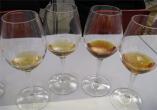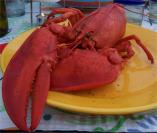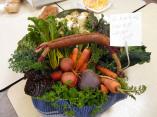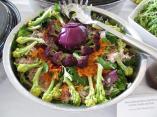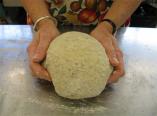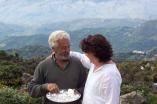I’ve been easing off the dairy products lately, though my cheese drawer still groans with long-lived goodness. One of the items that will always remain there is a hefty chunk of Parmigiano-Reggiano, a staple in my kitchen, as in many others I’m sure. It would probably startle many North Americans to discover that this is a raw milk cheese. Our governments allow it because it’s been aged over 60 days. It’s also salt-cured, which is a preserving process in many food products that helps to ensure food is safe by driving out liquids that can harbour pathogens, and making a generally unpleasant living environment for them.
One of my classmates at Unisg was Australian and she shocked us by revealing that the Australian government allows no raw milk cheeses at all, including Parmigiano-Reggiano! This is still the case, and there are rumblings that the 60-day threshold in the US could change. Here in Canada only Quebec cheesemakers are allowed to make raw milk cheeses: I have not heard of reports of an increase in sudden deaths in that province since the regulations were changed in 2008.
In the Rest Of Canada, as we are known, we have watched a long and painful battle between Michael Schmidt, who wants to share the right of informed citizens to drink raw milk (or turn it in to cheese I suppose) and the government turn sour; he’s currently on a hunger strike to protest the reversal of his earlier court victory upon appeal by the province of Ontario, after heavy lobbying by the province’s milk marketing board.
Into the fray comes Slow Food. Although they do not seem to be following the Schmidt case, they are tracking developments in other countries, including Australia, and have set up a Raw Milk website to promote the cause, which they take up largely for the sake of cheesemaking. Slow Food is, after all, the champion of good food: raw milk cheeses are simply better than pasteurized in many ways, including flavour and texture.
Raw milk contains microflora and natural enzymes that allow for more complex flavours and textures in cheese. Pasteurization destroys these as well as vitamins A and D which must then be added back to milk products in artificial form. Minerals such as calcium and iron are altered by pasteurization, as are the fats, and the digestibility of the final product. One of the arguments against the findings of the China Study was that it failed to make a distinction between pasteurized and unpasteurized milk products.
For drinkers of raw milk, there seems no respite from the government ban. In order to drink raw milk you need to own your own cow, and tell nobody. For the immune-compromised, it’s probably not a good idea to drink it, but among the healthy adults who prefer it, there are many arguments in its favour (as long advocated by the Weston A. Price Foundation). I drank it while in Italy, where the law allows people to make their own choice, by filling the milk bottle themselves (in my case from a dispenser provided by a local dairy that also sold cheese and other food products in a shopping mall). Despite the official warning signs posted on the machine, I watched a heavily pregnant woman fill her bottle; the presence of a small child with her suggested she may have survived a raw-milk fuelled first pregnancy already.
It is, as raw milk supporters would say, a puzzle why raw milk should be targeted when so many government-approved toxic substances are already on our tables. There is no ban on fracked tapwater, for example, nor on processed foods high in salt, sugar and fats which are proven to cause catastrophic health problems.

